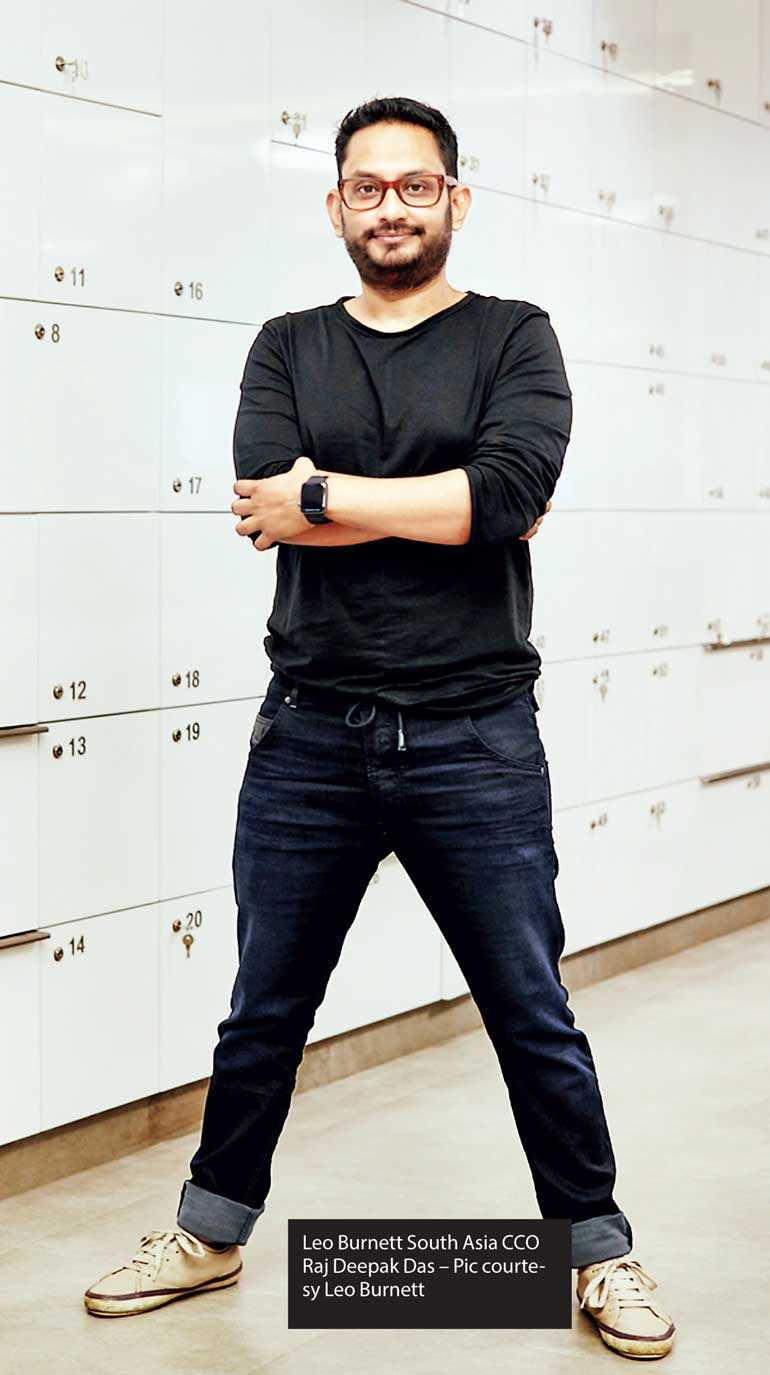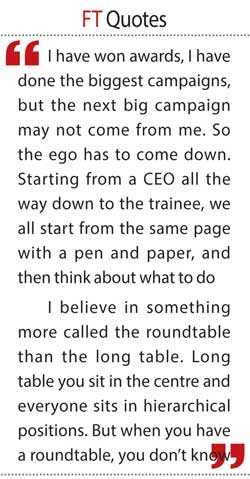Wednesday Apr 24, 2024
Wednesday Apr 24, 2024
Friday, 12 October 2018 00:00 - - {{hitsCtrl.values.hits}}
 By Madushka Balasuriya
By Madushka Balasuriya
Sri Lanka’s advertising industry is one of extremes, wildly careening from the cringeworthy to the sublime. Recently JAT Paints fell on the right side of this scale with the launch of its Petal Paints line, which takes discarded temple flowers and turns them into liquid paint, which can then be used to create and restore sacred temple murals in Sri Lanka.
The idea is one which possesses that elusive element which all great ideas share – the feeling that makes you want to say ‘why didn’t I think of that?’
“I think Petal Paints started one-and-a-half years back, and I remember in the boardroom a young team from Sri Lanka was presenting the idea,” recalls Raj Deepak Das. “I remember sitting there thinking ‘wow’. You know how sometimes the good ideas are so powerful it’s hard to ignore? This was that. Because no matter who or where it comes from, you can’t ignore the most powerful ideas.”
This is his mantra, and it’s one that has held him in good stead over the years, charting a path to him becoming, first, the youngest Executive Creative Director in India at 28, and then the youngest Chief Creative Officer in India at the age of 34. Presently he is the CCO for Leo Burnett South Asia where he looks over seven offices in four countries, including Sri Lanka.
But for someone to whom so much has come so young, Das remains grounded. As I meet him for our interview, he’s just concluding a workshop with several members of the Leo Burnett Sri Lanka team. I take a seat and wait patiently at a table across the room, though what strikes me is the informal nature of the discussion.
Chairs are arranged in a circle and Das, decked out in an uber casual dark printed t-shirt and denim jeans, is in an in-depth conversation with a handful of individuals, whom I presume are creatives – I would later be told that they were in fact from a variety of departments across the Leo Burnett family.
“There is PR expertise, there is digital, there is the creative team, there’s consumer engagement, there is media buying. Today was a collection of all of those people who need to come together to create campaigns for clients,” Das explains.
Keeping the brand
in the centre
This integration of ideas is what is at the centre of his creative process. It is also what enables him to ensure that the one overarching goal of any campaign is achieved keeping the brand at the centre, and solidifying its purpose.
“Something I believe in – and something Burnett believes in worldwide – is purpose. Why does every brand exist? For us it’s very, very important that the brand is in the centre.
“If you look at the piece of work, Petal Paints, it’s again keeping the product in the centre and solving a very simple, human, religious, faith problem, with design in the centre. That’s our main goal – how can we put the brand in the centre?”
The antithesis of this for Das is something he refers to as ‘silos’. In technical terms an ‘information silo’ is where an information management system is unable to freely communicate with other information management systems. Das sees similarities in the creative process.
“The last thing I want is a silo, the biggest brands are built without silo,” he says. “It’s how we make people live the brand experience. It can’t be just one thing or two things; it has to be everything together.
“This is why I believe in something more called the roundtable than the long table. Long table – you sit in the centre and everyone sits in hierarchical positions. But when you have a roundtable, you don’t know who is in the centre, people feel more comfortable.
“If it’s a long table and I’m sitting in the centre of that table, and you’re looking at me, I then have the authority to kill your idea. But the people who have a lot of ideas, a lot of it tends to happen at the bottom.”
Going back to Petal Paints, this was an idea that the entire Leo Burnett group worked on in terms of bringing it to life and ensuring the best possible version of the campaign came to fruition – even Leo Burnett Worldwide Executive Chairman Mark Tutssel had a hand, reveals Das.
“It’s rare that Mark Tussle gets involved in a campaign. I think over the last two years it’s one of the very few campaigns that he’s gotten personally involved in. The Canadian office was there as well. So if you look at it, we’re not looking at only how one or two people do it, to push the bar we got the best in the world to work on it.
“The idea was from the Sri Lankan office, the client is Sri Lankan, everything is Sri Lankan, but everyone still got involved to make sure we got the best idea out. And now, there is a benchmark for everyone to make the next big thing happen.”
K.I.D
But in order to move on to the next thing, and then the project after that, all the while maintaining that same level of drive, focus, and to use a French idiom, je ne sais quoi, it requires creative agencies to follow three simple rules, says Das – Kill your ego, Ideas we love, and Don’t let it go – K.I.D.
“I have won awards, I have done the biggest campaigns, but the next big campaign may not come from me. So the ego has to come down. Starting from a CEO all the way down to the trainee, we all start from the same page with a pen and paper, and then think about what to do.
“Then you have to walk in like kids – if they see someone has a better toy, they fight for that toy. I like that idea, because you have to know where to kill your idea as a team and fight for a better idea. Finally, when you love it, you have to take it to the end. Run with it.”
Setting up a culture with these precepts in mind however is no easy task, but he acknowledges that it needs to start from the top leadership.
“Cultures are built in two ways. First is top down. When you see the biggest guys in the room don’t have an ego, immediately you start putting down your walls as well.
“When I moved to Burnett the first thing I did was I removed the table that I had, and I made a coffee shop out of the space. The reason we have a coffee shop is because that is when ideas happen – when people talk to each other. That is why the Silicon Valley culture of coffee shops has become bigger.”
So what’s the second way? “There’s also a process for the team but I can’t tell you that – it’s a secret,” he deflects with a smile.
Shock marketing and bandwagoning
With Das not in the mood to divulge trade secrets, I look to get his opinion on some advertising trends in the industry recently.
The first is shock marketing, a strategy many folks would be familiar with, where an ad campaign seeks to attain publicity regardless of whether it’s good or bad. Adverts such as these are generally offensive in nature, but also tend to go viral.
“The good thing is that you’re talking about the ad, so the job is done,” explains Das, outlining why he thinks the tactic is a popular one. “In the time we live in, we have so many messages from Facebook - news, politics, corruption, fashion, new restaurants, tweets… everything is fighting for your attention. If they can take your mind space and we spend a few minutes talking about that ad, their job is done.”
That said, he still doesn’t believe in the strategy in terms of selling the actual brand in the longer term.
“I don’t believe in that much of shock advertising, because if the brand is not in the centre, you may talk about it but you may not buy the brand. See, there are two jobs as a brand custodian – because that’s what we are as the client believes in us; my job is not to just make noise, my job is to make people love me, that you stay with me, you purchase the product, and even after purchasing I will make sure you still love me. The workshop that we had is not just to create ideas, but how we can build that ecosystem for the client.”
Even so, there’s another trend emerging on the other end of the spectrum, where ad agencies bandwagon on current themes and social topics to boost their brands. This may not be as sinister as courting bad publicity for the sake of it, but it still rings just as hollow, according to Das.
“But now you see a lot of brands jumping on that saying ‘if it works for them, it works for me’. If instead of petal paints, if I do it for a random broom company, it doesn’t work. It works because I’m a paint company and I build paint for the houses, and now I’m actually painting the temples for a reason. Most of our ideas are brand ideas, not just creative ideas.”